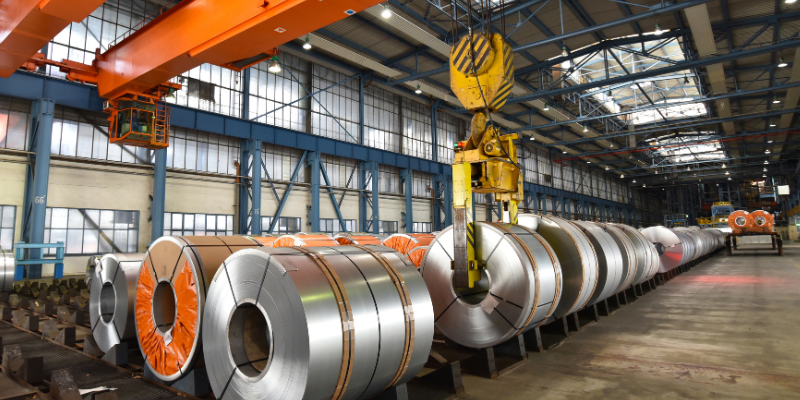$350,000 fine after critical crane injury; 5 tips for eliminating risks and protecting workers

Overhead cranes have become invaluable tools in manufacturing settings, thanks to their ability to easily move heavy objects and raw materials horizontally and vertically. But the increased use of bridge, gantry, jib, and monorail cranes for material handling comes with a heightened risk for catastrophic crane-related injuries and fatalities,” says Josh Paine, WSPS Specialized Consultant, Machine & Robotics Safety.
Injuries and fatalities can occur when the crane or load swings or falls, striking or crushing the operator or workers beside or below. “Cranes and their components – structural supports, hoisting mechanisms, wire cables and pullies – can fail when machines are not inspected and maintained according to the manufacturer’s instructions, or as a result of overloading, improper rigging, poor weight distribution, instability, exceeding load radius, or improperly secured loads,” says Josh.
A recent court case illustrates the repercussions of failing to protect workers. An Ontario manufacturer was recently fined $350,000 after a worker was critically injured while operating a crane. The worker was attempting to lift a 460-pound broach stick – a tool used in precision machining – with the crane’s clamping attachment, when the broach stick fell and struck the worker.
An investigation by the Ministry of Labour, Immigration, Training and Skills Development (MLITSD) found that the crane’s controls were not functioning properly and that the clamp attachment had not fully closed. A provincial court found that the company failed to ensure the broach stick was lifted, carried or moved in a manner that did not endanger the safety of the worker, contrary to their obligations under the Occupational Health and Safety Act (OHSA).
The MLITSD wants to see a reduction in crane-related injuries and fatalities and is focusing on overhead crane safety during its ongoing material handling inspection campaign, running til March 31, 2026. “Inspectors will check whether you are complying with the legislation and will ask to see both maintenance and training records,” explains Josh.
What the law requires employers to do
Employers’ duties with respect to cranes are spelled out in various sections of Regulation 851: Industrial Establishments under the OHSA, including:
- Section 45: Materials shall be lifted in such a way that does not endanger the safety of the worker.
- Section 46: Machinery, equipment or material that may tip or fall and endanger any worker shall be secured against tipping or falling.
- Sections 51-54 outline other requirements, among them that lifting devices are:
- thoroughly examined by a competent person to determine their capacity for handling the maximum load as rated
- inspected at least once a year; more often, if recommended by the manufacturer
- plainly marked to allow the operator to determine the maximum rated load that can be lifted under any operating condition
- equipped with a cab, screen, canopy guard or other adequate protection for the operator where the operator may be exposed to the hazard of falling material
- operated in such a way that no part of the load passes over a worker
- used only by competent persons
What ‘competent’ means in terms of operator training
The OHSA defines a 'competent person' as a qualified person because of knowledge, training, and experience to organize the work and its performance, is familiar with the OHSA and the regulations that apply to the work, and has knowledge of any potential or actual danger to health or safety in the workplace.’
In other words, crane operators need “to know the law, the job, the hazards specifically related to the crane, and the associated tasks to operate safely,” says Josh. “Operators require in-depth training, but, unfortunately, this level of training is often not provided.”
Dan Dukoff, CEO of Safe-Tech Training, agrees. Safe-Tech is a leading provider of industrial safety training in Ontario and WSPS’ official training partner for overhead crane safety. “There are a lot of companies that do little or no training,” says Dan, “increasing the risk of crane incidents and injuries and liability for the workplace.”
The crane operator’s role is complex, explains Dan. “It’s not just knowing how to move the crane up or down or right or left. That part is fairly simple. It’s the rigging of loads – how to connect to a load, how to find the load’s centre of gravity, how to ensure the load is within the crane’s maximum weight capacity, what kinds of slings or attachments to use, and so much more.”
Employers may not be providing this level of training for various reasons, says Josh. “Sometimes, employers don’t understand the law, and that specialized training is required, but ignorance of the law is not a defence if injuries occur.”
Often, employers think it will cost too much. “But the cost of a workplace injury, charges, and penalties will be far greater,” says Josh. Dan points out that, “If an injury occurs, one of the first things MLITSD investigators will look at is the type and level of training the employer provided to operators.”
Safe-Tech offers crane operator training based on the OHSA and CSA standard B167-16. The standard provides the most up-to-date guidelines for the design, maintenance, inspection and safe operation of overhead cranes.
5 tips for eliminating risks and strengthening crane safety
1. Develop policies, programs and procedures for your workplace based on CSA standard B167-16. Consider:
- legal requirements
- pre-start reviews
- roles and responsibilities of everyone in the workplace, including management, supervisors, and workers
- training and certification of operators
- pre-use inspections
- regular maintenance of the crane and its components, and
- pedestrian safety.
2. Maintain the crane and its components according to the manufacturer’s instructions. Develop a regular maintenance schedule and a checklist of the tasks involved, such as:
- lubricating moving parts
- inspecting and replacing worn or damaged components
- verifying safety devices and operational controls are functioning appropriately
- testing limit switches and overload indicators
- cleaning of all components to prevent the buildup of debris.
“Be sure to document your findings,” says Josh.
3. Carry out a full safety inspection of equipment. “The inspection must be carried out by a competent person on new equipment, and annually or as often as recommended by the manufacturer,” notes Josh.
4. Provide comprehensive training for operators. “To be considered ‘competent’, operators require training specific to the types(s) of overhead cranes they are using,” says Dan.
For example, an operator that uses a hoist to move one or two different types of simple loads may only require a basic hoisting program. An operator that moves large or complex loads will require more advanced training on elements such as rigging, turning and flipping of loads, weight calculations and more. In both cases, a practical evaluation is required to verify the operator’s skills and knowledge,” explains Dan.
5. Implement a pedestrian safety program. The law stipulates that no part of a crane’s load can pass over a worker. “Pedestrians in areas where overhead cranes are working can suffer crush or struck-by injuries if the crane or load fails,” says Josh. ”Pedestrian safety control programs and safety procedures need to be in place to protect workers from these types of injuries.”
“Investigating ways to segregate pedestrians while the crane is in operation is a good starting point,” suggests Josh. “We always encourage workplaces to consider the hierarchy of controls when selecting and evaluating possible solutions to control workplace hazards.”
Resources, training and support
Consulting
Connect with a WSPS consultant for help developing a crane safety program.
Training
- Safe-Tech’s Overhead Crane Training is a two-part program consisting of a comprehensive in-class theory session followed by practical operator training and/or testing. This program covers a broad spectrum of overhead crane operations and rigging, focusing on the equipment particular to your operation (bridge, jib, monorail, and gantry) and workstation, related components and attachments. Programs can be delivered on-site, and a 'train the trainer' program is also available. For more information or to register, please contact us at 1 877 494 WSPS (9777).
Free resources and support
- Prepare for Inspections: Lifting Devices, Mobile Equipment or Cranes (guide)
- Safety Connection: MLITSD Material Handling Campaign 2025-2026 (pre-recorded webinar)
- Preparing for a Ministry of Labour, Immigration, Training and Skills Development Inspection
- What to expect when a Ministry inspector comes to your workplace (article)
- Material Handling resources for workers, supervisors and employers - Worker resources are available in six languages.
- Business in Motion: Managing Material Hazards (free tool)
- Safety in 60 Seconds - Safe Lifting and Material Handling - Learn how to identify manual material handling hazards and how to perform safe lifting techniques.
The information in this article is accurate as of its publication date.




